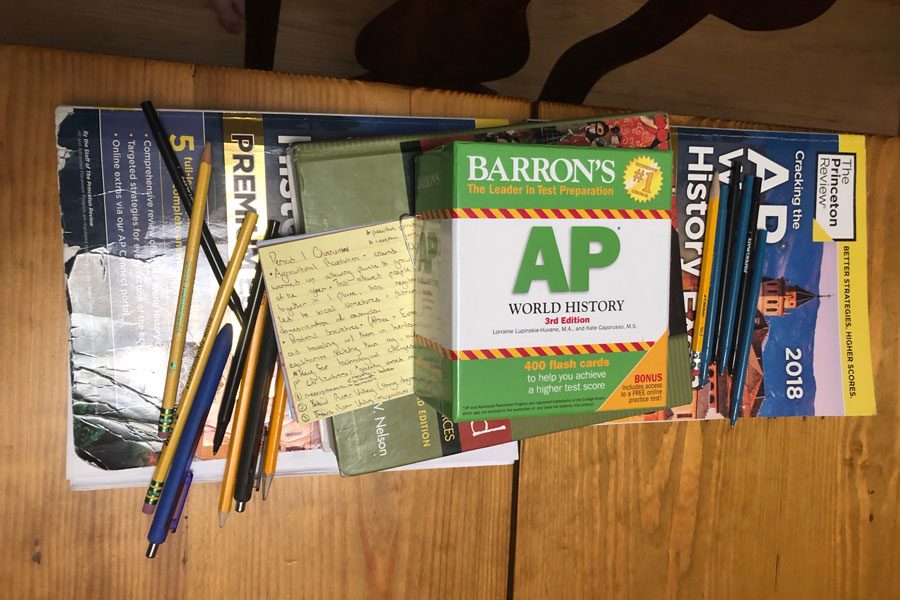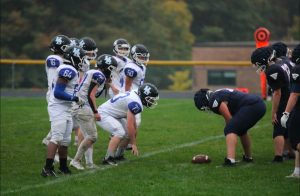AP World History- the ultimate review
June 13, 2018
On May 17, sophomore AP World History students were treated to miscellaneous fruits and juices before their end-of-year exam. A grueling four hours later, most of those exhausted students left the building, bemoaning their bruised brains and sore hands. Since the College Board has since released the open-response exam questions and the test is still a hot topic among WHAP students, it’s time for a review of the test, the year overall, and, most importantly, the breakfast.
PART 1: THE EXAM
As the AP World curriculum covers ten thousand years of world history, the test was similarly comprehensive. This expectedly makes it a very difficult exam to study for. Some read the provided textbook (written by Robert Strayer), others binge-watched John Green’s Crash Course World History series, and several students made hundreds of flashcards to review while hyperventilating in the extreme. “I got through maybe a fourth of the Crash Course videos [to study],” said Ram Senthil ‘20, a WHAP student.
The anxiety racking the sophomore WHAP students in the day before the exam was nearly palpable. Students freaked out on social media posts and frantically studied with their friends on topics ranging from Emperor Ashoka to Papua New Guinea’s agriculture. As the exam was the ultimate source of these last-minute panic attacks, that certainly counts as a point against it.
The test itself wasn’t too difficult for seasoned students. “It’s not easy, but it’s not that bad,” said Noah Penasack ‘20. “I certainly passed.” However, the pure physical difficulty of the exam was a little much for some. Students left comparing the swollen and reddened writers’ calluses on their hands, lefties complaining about the ink stains along their pinkies. The task of writing for nearly four straight hours in tiny, cramped boxes is not normally undertaken by us weak Gen-Z typists, so the hand exercise counts as another point against the WHAP exam.
If there was anything good about the exam, it was certainly the stickers. The act of peeling off stickers from student handbooks and applying them to carefully-marked boxes provided a much-needed sense of satisfaction and control to the whole experience. The tests themselves were also carefully wrapped in a thin sheet of plastic, and the feeling of unwrapping them was not incomparable to gift-unboxing during a birthday party (albeit a party with sixty sleep-deprived sophomores crammed into a gym in the most uncomfortable chairs in existence).
However, what ruined the exam for many was not even the test itself- it was the changes that the College Board promised to make in the future. Starting in the 2019-2020 school year, WHAP students will not be expected to learn history from the beginning of time to the present; the curriculum will start at 1450 CE. Several student interviewees were unaware of the future changes, and the knowledge did not make them happy. “No way,” said Senthil, unlocking his phone to fact-check my information. “You’re joking. What the [expletive], man? That’s awful. That is insane. I hate that. You’re serious?”
Besides vindictiveness and a revenge-driven need to force the current eighth graders to undergo the same suffering all WHAP students have dealt with up to this point, there is legitimate reason to be upset over the decision. “I fundamentally disagree with [the College Board] getting rid of Period 3, [600-1450 CE]. I love Period 3, and it’s also this period where we get to emphasize states that aren’t mentioned in other classes. It’s one period where Europe isn’t on top of the world, for once- they were eating dirt! That [decision] really hurts me,” said Christina Ellis, who has taught WHAP for two years.
Period five AP World history teacher, Jennifer Given was also enraged by the proposed changes by the College Board. “[If] you are only going to be talking about European history, and then if you are talking about Asia or Africa or the Middle East, you are primarily talking about their downfalls or exploitation or slavery… None of those are positive portrayals of the people that live in those places. I think that that is a crime,” said Given. Based on her strong emotions towards the College Board’s more Eurocentric leanings, she continued on to assure that these proposed changes will not affect the way the course will be taught beginning in 2019.
Thus, despite the satisfying stickers, the WHAP exam was disappointing in quality. It was unrivaled in its ability to cause chaos and anxiety in the sophomore class for several weeks, in the agony it caused those with more delicate hands, and in the absolute howl of rage it triggered in Ellis’s fourth-period AP World class when they were told of the new curriculum decision. But doI still recommend taking it? Absolutely.
PART 2: THE COURSE
The emblematic AP World history course covers over ten thousand years of world history in less than 178 days each year. As dictated by the College Board, world history is split into six time periods, beginning in the years before 600 BCE and ending in the modern era (although some do argue that today is part of period seven). Each period has its own nuances and key historical developments, but there are five themes that stay constant throughout time, which according to the College Board, include the following: “Interaction Between Humans and the Environment. Development and Interaction of Cultures. State Building, Expansion, and Conflict. Creation, Expansion, and Interaction of Economic Systems. [And] Development and Transformation of Social Structures.”
Both AP world history teachers, Ellis and Given, structure the curriculum to fit the required parameters and the constraining time limit of the school year. “Well currently WHAP is divided into six periods. And mostly through completely lucking out we spaced it out the first year and it paced appropriately and we’re really not sure how we did that. So then we just take each of the periods and… try to make sure we’re about halfway through human history by the midterm and close to all the way through by the exam. We started backwards engineered from there,” said Given.
So besides history, what exactly does WHAP entail? Well, on top of the basic history, the course also focuses on improving student’s writing skills through short essay questions (SAQ), long essay questions (LEQ), and document based questions (DBQ). These timed essays challenge students’ analysis skills and ability to provide specific historical examples in an understandable context. The whole idea of the writing components seems terrifying at first, and on the exam, but through the abundant in class practice and assignments, students become experts. “I felt really good about those prompts. Actually, I think a couple of them we actually used, not the wording, clearly we don’t have psychic abilities (or do we). I was feeling really good I looked at them [and the prompts seemed] really fair….Only based on the feedback from the kids they seems to be really prepared,” said Given, suggesting the hard work her and Ellis put into improve the student’s writing abilities paid off.
One of the highlights of the curriculum includes the infamous projects. These assignments, though few, can be disastrous if not well planned out. For example, there was the “empire autopsy” project for period two, the “crash course” movie for period four and of course the period six website project. While stressful, which is to be expected of an AP course, the projects themselves were entertaining and fascinating to learn about. A quick tip for future AP world history students, although it may seem tempting to procrastinate, use your time wisely!
During the class periods, students often have time to work on the period projects, hone their writing skills, or learn about some historical concept. Full disclosure, there is a ton of note taking, though mainly outside of class. Each week, for extra credit, there is a certain number of pages in the Strayer textbook that the students are assigned to read and take notes on. Taking notes is highly encouraged as the extra work truly pays off on the period exams. In fact, not only do the notes prepare the student for the test and provide a great study tool, they also as many as five points onto the final score of any period test.
Of course, considering the amount of information thrown at students in such a short amount of time, there are several key supplementary materials add into the mix. The most iconic course enrichments are as follows: John Green’s Crash Course World History, the works of Jared Diamond and The History of the World I Guess by Bill Wurtz (the clean version). These three materials form the WHAP holy trinity which Kathryn Fry ‘20, along with many other students, attributes her success to. Some other things students find it important to have are the Barron’s WHAP study cards and the Princeton Review Premium AP World History study book. “Great tools for cramming, I would highly recommend” said Martin, happily encouraging future WHAP students to buy the Princeton review study book for their benefit.
John Green is well loved for many things, especially his Crash Course videos. In AP World history the videos are used to provide a visual representation of history and give students a funny perspective into the events. Yet, unfortunately it isn’t perfect. “I love John Green. I suppose he could slow down. And I love Thought Bubble, so maybe more Thought Bubble and slow down a little bit there, John,” said Given.
Jared Diamond, on the other hand, is absolutely perfect. “I love Jared Diamond too. We will use his “Guns, Germs, and Steel” Theory to explain inequality the world, both ancient and modern. I also like to use his article on agriculture being the worst mistake in human history to counter the common perspective that agriculture was inevitable and positive. He gives a point of view that challenges the prevailing point of view that you have coming into the course which I like,” said Given. The materials provided by Diamond are very thought provoking and make students go beyond the boundaries of their textbooks and ask more questions about the equality of development.
In the end, students tend to get from WHAP what they put into the course. Hence the reason taking notes and working hard on projects is so important. But overall, the students believe that the course was totally worth it. “WHAP was the best time of my life. It was full of stress, good times and a lot of feminism,” said Mary Martin ‘20. Taking AP world history was definitely one of the best decisions of my academic career as it was for Fry and Martin.
PART 3: THE BREAKFAST
Among AP World students, there were mixed feelings about the breakfast provided for test-takers, consisting of bagels and mixed fruits. Some praised its healthiness. Others bemoaned the lack of good, classic, American breakfast foods, like pancakes and hashbrowns. Even more didn’t care remotely.
Regardless of taste opinions, fruit (and fruit juice) is inarguably healthy for a growing teenager about to take a four-hour test. It has plenty of vitamins, to keep you going long after your brain urges a collapse. “I had a clementine and some orange juice,” said Senthil, who partook in the breakfast with his peers. “It tasted pretty good.”
Other students avoided the fruit, going straight for the carb-heaviest food available: bagels. “I had a bagel,” said Penasack. “I wish it was provided by Bagel Alley, but it was pretty good. Actually, there should have been waffles. Just make waffles. Forget what I said about Bagel Alley.”
Beyond the food, which was either a hit or miss, the get together itself was exactly what the WHAPers needed right before the exam. Ellis and Given created inspirational posters with the ionic slogan “We Terra-got This” (a play on the historic Terracotta Warriors) to wish their students luck on the exam. Starting at 7am, AP world history students from both periods four and five mingled, eating snacks while quizzing each other on random, and mainly obscure world history events. The stress level in that room was so incredibly high that some students ended up going for a walk to burn off some of the excess hyper energy.
Given’s classroom was filled with the noise of frantic studying, questions about Persia and the sharpening of precious number two pencils. “It was full of screaming and was the perfect way to get pumped up for the exam,” Martin said.
The comradery and sense of togetherness amongst the students was truly amazing. However, nothing was quite as symbolic as the Strayer prayer, read by Caleb Clark ‘20, in order to call the breakfast to an end and send the AP world students off to the exam.
Overall, the breakfast was a success, though it could have arguably used more waffles. Students also appreciated the pre-exam study time, and the few minutes of shared anxiety and fruits was definitely worth having.














